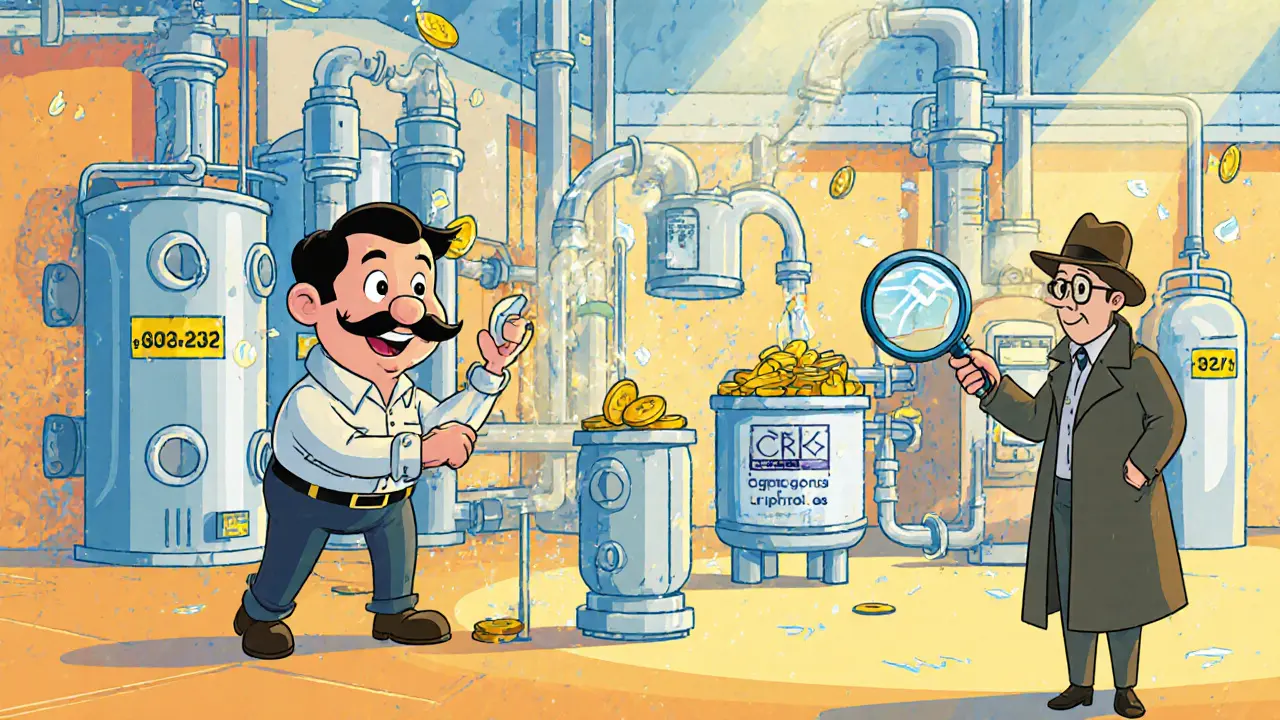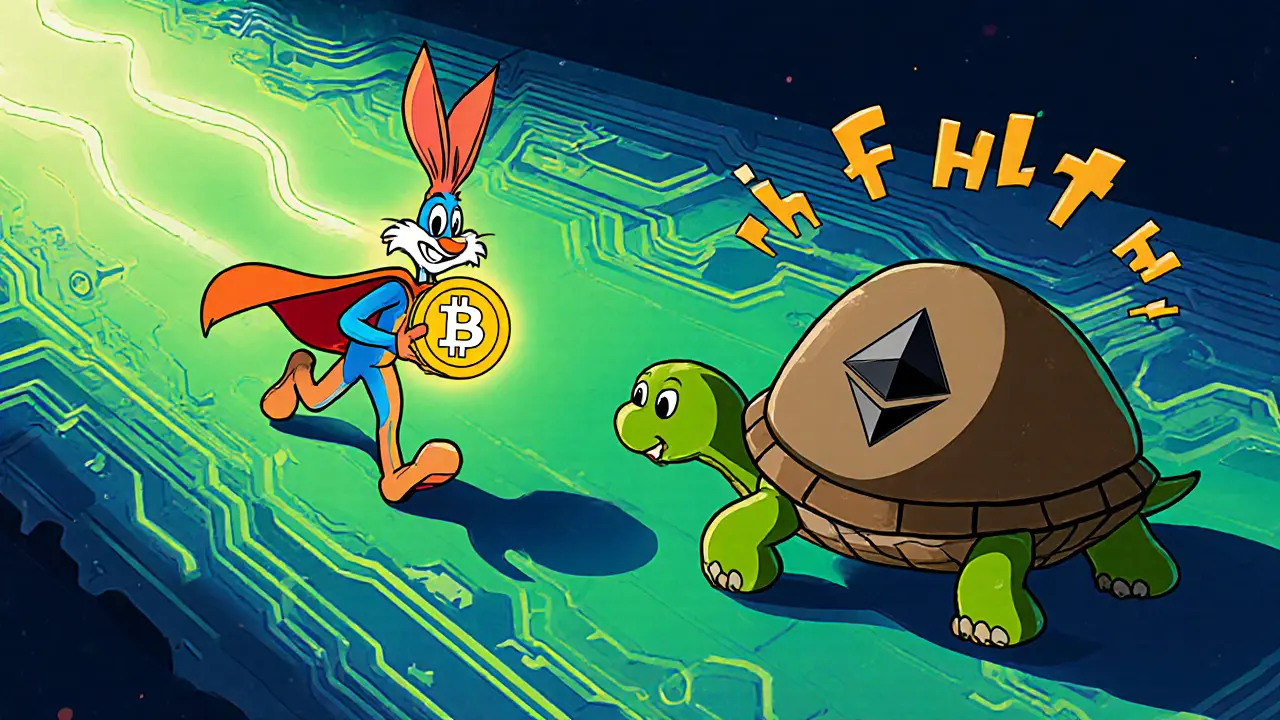DragonSwap Gas Fee Calculator
Compare Swap Costs
DragonSwap processes swaps in 400-600 ms at 0.3% flat fee, translating to about $0.002 per transaction - over 600x cheaper than Ethereum-based DEXes.
Key Takeaways
- DragonSwap v1 processes swaps in 400‑600 ms, far quicker than Ethereum‑based DEXes.
- Flat 0.3% fee translates to about $0.002 per transaction - over 600× cheaper than Uniswap on Ethereum.
- Concentrated liquidity boosts capital efficiency by up to 400%.
- Security audit by CertiK found three medium‑severity issues, all patched in the V1.1 update.
- Main limitation: confined to the Sei Network, no native cross‑chain bridges yet.
If you’ve been hunting for a DEX that feels like a high‑frequency trading platform but still works for a weekend hobbyist, the DragonSwap review you’re about to read will give you a no‑fluff rundown. We’ll cover how the protocol works, what the numbers say about speed and cost, how safe it feels, and whether it deserves a spot in your DeFi toolbox.
What is DragonSwap v1?
DragonSwap v1 is a decentralized exchange (DEX) built on the Sei Network, a parallelized EVM‑compatible layer‑1 that promises sub‑second block finality. Launched in October 2023, it serves as the core liquidity hub of the Sei ecosystem, offering instant token swaps, concentrated liquidity, liquid staking and even prediction markets-all through a single smart‑contract suite.
Core Architecture & Performance
The platform follows a binary contract model: a singleton factory creates a unique pair contract for every token pair. That pair contract acts both as an automated market maker (AMM) and as the keeper of pool balances. By keeping the codebase “brutalist” - i.e., minimal and auditable - the attack surface stays small.
Performance metrics from Nansen’s April 2024 report show the DEX handling roughly 14,000 TPS during peak hours, with average confirmation times between 400‑600 ms. By contrast, Uniswap V3 on Ethereum averages 13‑15 seconds per block. The speed advantage matters most for arbitrage bots and high‑frequency traders who can’t afford even a half‑second lag.
Fees & Liquidity Mechanics
Fees are fixed at 0.3 % per swap. Of that, 0.25 % goes straight to liquidity providers (LPs) and 0.05 % is funneled to the protocol treasury for future upgrades. Because the fee is flat, you’ll see a typical gas cost of $0.002 - a 99.8 % reduction versus the $1.27 average on Ethereum during the same period.
DragonSwap supports concentrated liquidity, a feature first popularized by Uniswap V3. Instead of spreading capital across the entire price curve, LPs can choose narrow price ranges, which can crank up capital efficiency by up to 400 % according to ICOholder’s May 2024 analysis. The trade‑off is a slightly higher learning curve: LPs must understand price‑range selection to avoid impermanent loss.

User Experience & Onboarding
Onboarding takes about 8‑12 minutes for anyone familiar with DeFi concepts. The biggest friction point is wallet configuration - you need a Sei‑compatible wallet such as Keplr, Leap or Front. Once the wallet is linked, the UI lets you swap tokens in three clicks. New users generally need 3‑5 swaps to feel comfortable, according to DragonSwap’s internal UX study (July 2024).
Support is primarily Discord‑based, with an average response time of 22 minutes on weekdays. Documentation scores 4.3/5 for API coverage but gets lower marks for explaining concentrated liquidity and impermanent loss, a pain point highlighted by 41 % of negative Trustpilot reviews.
Security & Audits
CertiK’s March 2024 audit uncovered three medium‑severity flaws in the initial V1 code, mainly around price‑oracle validation. DragonSwap’s team patched all three in the V1.1 rollout (April 2024), and subsequent re‑audit reports listed the protocol as “clean” for production use.
Beyond the formal audit, the on‑chain track record shows less than 0.3 % of swaps suffering front‑running attacks, even during volatile market swings. Nansen’s August 2024 rating gave DragonSwap a 4.2/5, praising throughput and fee structure while flagging liquidity concentration as a risk.
How DragonSwap Stacks Up Against Rivals
| Metric | DragonSwap v1 | Uniswap V3 (Ethereum) | PancakeSwap (BNB Chain) |
|---|---|---|---|
| Avg. confirmation time | 0.5 s | 13 s | 1.9 s |
| Gas fee per swap (USD) | 0.002 | 1.27 | 0.0042 |
| TVL (USD, Sep 2024) | 87.3 M | 2.4 B | 1.1 B |
| Weekly active users | 42 k | 1.7 M | 620 k |
| Liquidity concentration (top pair % of TVL) | 78 % (SEI‑USD) | 32 % | 45 % |
In raw speed and cost, DragonSwap wins hands down. The trade‑off is a shallower liquidity pool and a tighter ecosystem. If you need to trade obscure tokens that only exist on Ethereum or BNB Chain, you’ll find fewer counterparties on DragonSwap.

Community & Ecosystem
The DEX commands 43.7 % of Sei’s total DeFi liquidity, making it the go‑to hub for SEI‑related assets. Its Discord community boasts over 12 k members, with daily trading chats and weekly developer office hours. Institutional interest is still nascent - only three hedge funds have publicly disclosed using DragonSwap for arbitrage as of September 2024.
DragonSwap also secured $2.5 M from the Kaia Foundation’s D2I program to fund ecosystem tooling. The roadmap shows a V2 migration slated for Q1 2025, which will add cross‑chain bridges via Sei’s upcoming interchain accounts. That could address the biggest criticism: limited asset diversity.
Risks & Future Outlook
The biggest risk remains its dependence on Sei’s broader adoption. Analysts at Delphi Digital warn that if Sei captures less than 5 % of the layer‑1 DEX market by 2026, DragonSwap’s value proposition could diminish sharply. Conversely, Messari projects a 22 % quarterly user‑base growth through 2025, driven by mobile wallet rollouts and the V2 cross‑chain feature.
Regulatory pressure on liquid‑staking services could introduce compliance costs, but no formal actions have been taken yet. From a technical standpoint, the architecture is sound, and the team has pledged to support V1 at least through Q4 2026.
Bottom Line
DragonSwap v1 shines when you need blister‑fast swaps and rock‑bottom fees, especially for SEI‑centric trading pairs. It’s less attractive if you’re chasing deep liquidity on a wide range of tokens outside the Sei ecosystem. With a solid audit, an active community, and a clear V2 roadmap, it’s a platform worth keeping an eye on - just don’t expect it to replace your multi‑chain DEX suite overnight.
Is DragonSwap safe to use?
Yes, the protocol passed a CertiK audit in March 2024 and all identified medium‑severity issues were patched in the V1.1 update. Ongoing on‑chain monitoring shows less than 0.3 % of trades experiencing front‑running attacks.
How do fees on DragonSwap compare to Ethereum DEXes?
DragonSwap charges a flat 0.3 % swap fee, which translates to about $0.002 per transaction on average. Uniswap V3 typically costs around $1.27 per swap, making DragonSwap over 600 times cheaper.
Do I need a special wallet to trade on DragonSwap?
Yes, you need a wallet that supports the Sei Network’s EVM layer - popular choices are Keplr, Leap and Front. Once connected, the DEX works like any other web‑based interface.
Can I provide liquidity on DragonSwap?
Absolutely. The platform offers concentrated liquidity, letting you allocate capital to specific price ranges for higher efficiency. Keep in mind the need to monitor impermanent loss, especially in volatile pairs.
What’s the roadmap for DragonSwap after V1?
The team plans a V2 upgrade in Q1 2025 that adds cross‑chain bridges via Sei’s interchain accounts, expands liquid‑staking options, and improves slippage handling during high‑volatility periods.

Speed feels like a flash of light, a reminder that our markets are moving faster than the eyes can catch. The cheap fees make me think about who’s really paying the hidden costs behind the scenes. If the Sei network is a secret hallway, who holds the keys? It’s a neat tool, but I can’t shake the feeling that someone is watching every trade.
We revel in the sub‑second swaps, yet the underlying consensus still relies on a handful of validators that could be swayed. The audit patched issues, but what about the unknown vectors that never get a spotlight? The architecture is clean, but clean can also be a mask for hidden complexity. I watch the ecosystem like a quiet guard, hoping nothing slips.
The performance metrics presented are impressive, particularly the sub‑second confirmation times relative to Ethereum’s latency. From a risk management perspective, the reduced transaction costs substantially improve net return calculations for liquidity providers. Nonetheless, the concentration of liquidity on a single pair (78% on SEI‑USD) could expose the protocol to systemic shocks. It would be prudent for users to diversify exposure and monitor the forthcoming V2 cross‑chain capabilities.
Concentrated liquidity is a game changer it lets LPs earn more per capital unit but it also demands precision choose your price range wisely or suffer impermanent loss
Looks fast but I’m not convinced it’s worth the switch.
Ah, the marvel of sub‑second swaps-truly the pinnacle of human achievement in decentralized finance, eclipsing every other DEX with the grace of a snail on a treadmill. One can only marvel at the ingenuity required to reduce a $0.002 fee, a feat surely rivaling the invention of the wheel. Yet, let us not forget the glaring deficiency of being confined to a solitary ecosystem; a true masterpiece, indeed.
Yo, this DragonSwap thing is just another hype train, and if you think 0.5 sec is super fast you’re blind. The certik audit? Yeah right, they patched somethng and called it clean. I’d rather stick to Uniswap even if it costs a buck, at least I know its not some secret lab experiment. Get real.
Guys this is sooo cool check out how cheap swaps are ur wallet will thank u lol its easy to start just get a sei wallet and you’re good
Fast swaps? Sure, but speed alone won’t save a DEX built on a single chain.
Wow, the numbers are dazzling-like watching a fireworks show of efficiency! I love how the fee structure practically whispers “you’re welcome” to traders, and the concentrated liquidity feels like a finely tuned orchestra. Still, the ecosystem’s narrow focus reminds me of a garden with only one kind of flower; variety would make it even more vibrant. Let’s keep an eye on that V2 bridge, it could turn this into a real biodiversity hotspot.
Yo, this DragonSwap thing is lit! Swaps faster than I can finish a pizza, fees so low I’m pretty sure my grandma could trade on it. But seriously, if you’re stuck on one chain, it’s like having a Ferrari with no road.
From a theoretical standpoint, the reduction of transaction costs to $0.002 represents a significant advancement in market efficiency. The integration of concentrated liquidity further optimizes capital deployment, aligning with modern DeFi principles. Nevertheless, the current lack of cross‑chain bridges remains a notable limitation. 📈🚀
Honestly, the speed and low fees are a game‑changer! If you’re not on DragonSwap yet, you’re missing out on the future of DeFi trading. Let’s rally the community and push for that cross‑chain bridge-together we can make this the top DEX.
I understand the excitement surrounding DragonSwap’s sub‑second swap times, and I’m grateful for the community’s enthusiasm.
The reduction of fees to a mere $0.002 per transaction is truly a relief for small traders who have long been burdened by high gas costs.
It’s also encouraging to see a thorough audit by CertiK that identified and patched vulnerabilities, showing a commitment to security.
Yet, I can’t help but notice the heavy concentration of liquidity on a single pair, which could pose risks if market conditions shift dramatically.
This concentration makes sense from an efficiency viewpoint, but diversification across more assets would provide a sturdier safety net.
The user onboarding experience is commendable; an 8‑12 minute setup is reasonable for most DeFi users these days.
However, the necessity of a Sei‑compatible wallet adds an extra step that may deter newcomers unfamiliar with that ecosystem.
I’m also aware that the Discord support team averages a response time of 22 minutes, which is fairly prompt, but could improve during high‑traffic periods.
The lack of native cross‑chain bridges is a glaring limitation, especially for those who trade across multiple blockchains daily.
The upcoming V2 roadmap, promising interchain accounts, offers hope that this gap will soon be bridged.
In the meantime, users must weigh the trade‑off between speed and asset variety, deciding what matters most to their strategies.
From a broader perspective, the success of DragonSwap will likely hinge on the wider adoption of the Sei Network itself.
Analysts’ predictions vary, but the projected quarterly user‑base growth suggests a positive trajectory if the team delivers on its promises.
I appreciate the community’s active engagement, with over 12 k Discord members sharing insights and helping each other navigate the platform.
Ultimately, I believe DragonSwap presents a compelling option for those focused on the Sei ecosystem, while also encouraging the team to broaden its horizons for the benefit of all.
Thank you for such a thorough reflection; your balanced perspective highlights both the strengths and the areas for growth, and I trust the community will continue to support the upcoming enhancements.